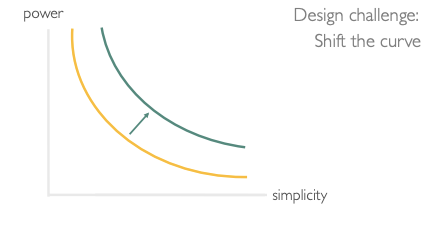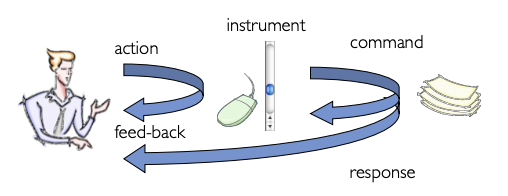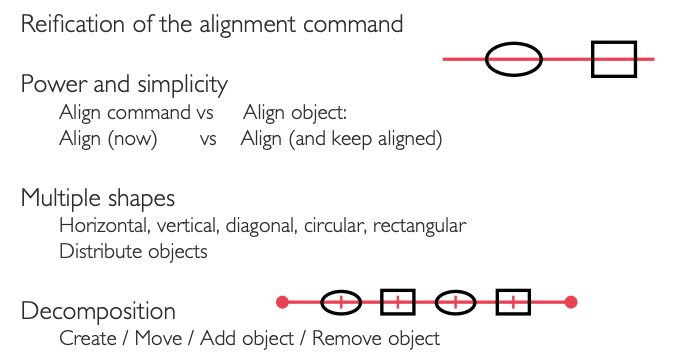Situated Interaction - INSTRUMENTS AND SUBSTRATES
Notes of:
FUNDAMENTALS OF SITUATED INTERACTION - 16 SEPTEMBER 2016 MICHEL BEAUDOUIN-LAFON UNIVERSITÉ PARIS-SUD & INSTITUT UNIVERSITAIRE DE FRANCE
Professor: Wendy E. Mackay
https://www.lri.fr/~mbl/Teach/SituatedComputing/2016/#l2
Lecture 1
Introduction
INVENTION OF THE TOOL
- Humans are the only species that creates tools to shape their environment;
- Traces of tools have been found as far back as 3.3 million years;
Most of our interactions with the real world are mediated by tools and instruments.
Tools to shape our environment, but not always easy to learn.
A bit of psychology
AFFORDANCES
- We directly perceive the capabilities for action of an object ;
- … the affordances of the environment are what it offers the animal, what it provides or furnishes, either for good or ill…” James Gibson
PERCEPTUAL LEARNING
- Learning to recognize affordances;
- “We perceive to learn, as well as learn to perceive” Eleanor Gibson;
SIGNIFIERS
- Affordances as redefined by Don Norman;
- To be perceived, an affordance must be visible;
THE POWER OF TOOLS
- We internalize the tool as a physical extension of our body;
TECHNICAL REASONING
- We simulate in our head the physical mechanism to solve a problem;
- We appropriate the objects at hands;
APPROPRIATION
- A pen or a ruler?
- A mug or a compass?
WHEN YOU HAVE A HAMMER…
- We create tools because we overestimate their capabilities;
What about digital tools?
GRAPHICAL INTERACTION
- SKETCHPAD IVAN SUTHERLAND, 1963
COMPUTER AS TOOL
- “Computers are like a bicycle for our minds” Steve Jobs
FROM PHYSICAL TOOLS TO DIGITAL TOOLS
Instrumental interaction
INTERACTION IS MEDIATED BY A TOOL
A DESCRIPTIVE MODEL
- From direct manipulation To tangible interaction
- But not universal:
- Voice-based interaction?
- Gesture-based interaction?
CPN2000
REIFICATION
- Transform a command into an object that can be directly manipulated;
- Example : alignment
- STICKYLINES M. Ciolfi, N. Maudet, W. Mackay, M. Beaudouin-Lafon
POLYMORPHISM
- The same tool can be used in different contexts;
- Example : color selector;
- Free the tools from the applications where they are trapped!
REUSE
- Output reuse (objects);
- Example : copy-paste
- Input reuse (commands)
- Example : redo, macros
UBICOMP INSTRUMENTS
- Instruments spanning multiple interaction surfaces;
- Multi surface interaction;
- VIGO (CHI’09);
Information substrates
INSTRUMENTAL INTERFACES
- To create and edit content
- BUT limited: How to use the pen from the “Paper” app to write on a photo in the “iPhoto” app?
INFORMATION SUBSTRATES
- Data does not exist in a vacuum;
- Substrates provide context for interpreting data and constraints for presenting and interacting with it;
- Examples: musical score, spreadsheet, page layout, graph…
PAPER SUBSTRATES
- Support the music composition process by combining and interpreting notations in various ways
INSTRUMENTS & SUBSTRATES
- Instruments can manipulate substrates;
- Instruments probe the substrate for specific properties or protocols to decide if they can operate;
- Instruments are themselves substrates;
- Instruments can be embedded in substrates;
- WEBSTRATES C. Klokmose, J. Eagan, S. Baader, W. Mackay , M. Beaudouin-Lafon
LAYERING SUBSTRATES
- A substrate can represent data in another substrate;
- Instruments can modify the different substrates in the stack;
- Example: A table substrate - edit a value A graph substrate - set its type A histogram - set its color An image - paint on it
Conclusion
INTERACTION FROM FIRST PRINCIPLES
Reinventing interaction by separating tools from applications, and replacing applications with shareable and appropriable information substrates
Lecture 2
Human-Computer Partnerships or
Co-Adaptive Instruments
Computer hardware has changed dramatically over the past 40 years …
Computer capabilities are exploding but human capabilities are not ...
Can computers augment human capabilities?
Key Research Challenge
How can we improve interactive systems, given today’s ever-increasingly complex computational environment?
Situated Interaction
Focus on interaction
we cannot effectively model user behavior without taking context into account
Human behavior is planned, but action is situated: plans are a resource for action, not the action itself
Differentiate between measuring data and understanding the complexities of context
Methodology
Generative theory
- understand co-adaptive interaction
- principles for creating co-adaptive instruments
Participatory design with creative professionals
- develop novel prototypes
- real-time interaction
- personal language creation
- long-term reusable patterns of interaction
Empirical studies
- controlled laboratory studies
- extended field studies
ExSitu
focuses on: reinventing interactive software to support creative activities … based on two key ideas
We have multiple relationships with computers
- Computer as a tool I accomplish the task myself
- Computer as a servant It accomplishes the task for me
- Computer as a medium It lets me communicate with other people
Competing views of the future
Artificial Intelligence or Human-Computer Interaction
GUIs are a vindication … and a challenge
Designed for executive secretaries to process documents in a completely different technology environment
Dates back to the 1970s to: copy hand-written notes check for mistakes format on letterhead
Problem: Brilliant then, out-moded today
Human-Computer Interaction research fought hard to make interfaces easier to use Today, novices easily accomplish simple tasks
Yet … advanced research in interaction techniques is rarely adopted in commercial systems
Today, experts use ineffecient techniques and are constantly forced to change their behavior
Desktops, the web and apps …
- Require constant relearning:
- each new version introduces arbitrary changes
- each system requires slightly different interaction
- Require high visual attention
- Do not scale
- Depend on specific devices
Smartphones are easy … but not powerful
We need to reassess human-computer interaction
- Early assumptions about graphical user interfaces no longer hold
- Everyone, not just experts manages increasing quantities of data faces information overload constantly relearns the details of interaction
- Redefine what we mean by “computer literacy”
Design Trade-offs
- Goal: Simple things should be simple … complex things should be possible
- Fundamental challenge: Balance trade-off between: power of expression simplicity of execution
- Design challenge: Shift the curve

Strategy
Combine two key concepts
- Instrumental interaction (Michel Beaudouin-Lafon)
- Co-adaptive phenomena (Wendy Mackay)
Instrumental interaction
Two levels of interaction: interaction with the instrument mediation with the system, Michel Beaudouin Lafon (2000)

Magnetic guidelines

What makes an object an instrument?
Relationship between the user and the object
Human-Computer Relationships
- Between people and physical tools:
- follow well-known physical principles users can learn them
- users can appropriate them
- Between people and computer tools
- follow arbitrary constantly changing rules
- users must learn, and relearn, and relearn them users break them when they try to appropriate them
Focus on interaction, not interfaces
How can we let users control interaction
- in a flexible, reusable way,
- developing expertise without constantly relearning skills?
Solution: Co-adaptive Instruments
- Separate interaction from data and functionality
- Interaction becomes a first-class object
Co-adaptive phenomena
- Inspired by co-evolution in biology
- Organisms create their environment
- even as they adapt to it
在适应环境的过程中创造环境
- Anaerobic bacteria change the atmosphere making it possible for aerobic bacteria to emerge
- Users change spreadsheets from an addition tool to a tool for exploring ‘what if’ scenarios(?)
Key phenomenon: Co-adaptation
- Users adapt to a new system they learn to use it
- Users adapt the new system to their own needs they appropriate and change it
Co-adaptive instruments
- Creative activities require both especially when integrating physical and digital information
- Create digital tools that are as intuitive, and learnable, as physical tools
Co-adaptive Instruments
- Worthwhile spending time and energy learning them
- Complex tools become accessible
- can learn cognitive and sensori-motor skills
- can adapt to new situations
- Move beyond graphical user interfaces to expert instruments
- To do this: Extract widgets from applications to create personal instruments
Reciprocal Co-adaptation
- People adapt their behavior to technology… they learn it
- People adapt the technology for their own purposes … they appropriate it
- Computers adapt their behavior to people … machine learning
- Computers adapt human behavior … training
Human-Computer Partnerships
People have rich cognitive and sensory motor capabilities
increasingly,
so do computers
Why is the interface so limited?
- Physical tools
- follow the laws of physics
- we learn them
- we appropriate them
- Computer tools
- follow the whims of programmers
- we learn, and relearn and relearn
- and then we break them!
Our vision
- Software tools should be incrementally learnable
- People should choose and control their own tools
- Software tools should be easy to appropriate



 浙公网安备 33010602011771号
浙公网安备 33010602011771号